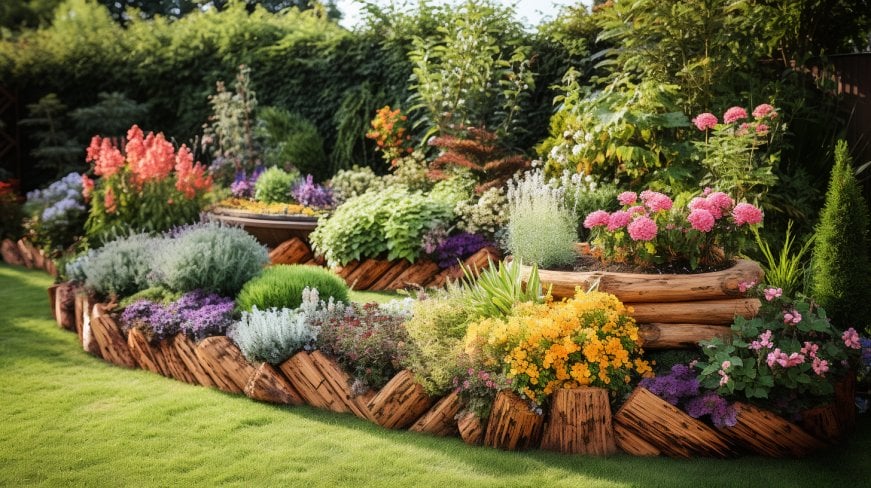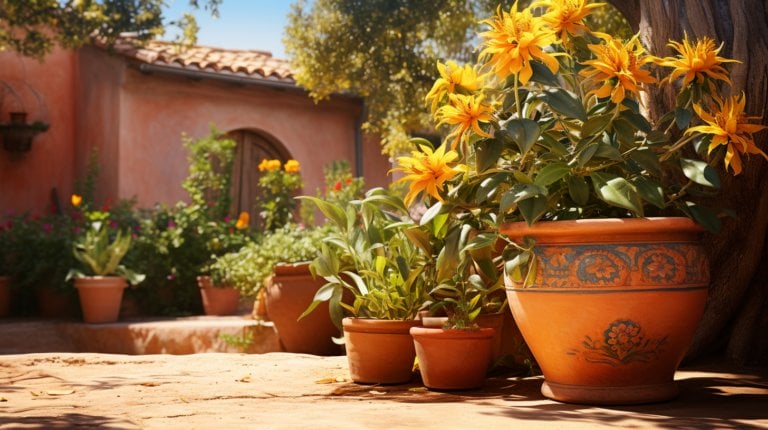How to Make a Garden Border with Wood: Best Landscape Garden Edging
Over the years, I’ve accumulated several handy pointers and strategies. One that I particularly enjoy involves creating boundaries for gardens using wood. Are you keen on discovering how to construct a wooden edge for your garden? Let’s delve into the specifics.
It’s not just about aesthetics; it’s also practical. Wood can help keep soil and mulch in place, protect plants, and even extend the growing season.
In this guide, I’ll share how you can make your own wooden garden border. It’s easier than you might think, and it’ll give your garden an appealing, rustic look.
Key Takeaways
- Pressure-treated wood is a cost-effective and durable option for garden edging, as it is rot-resistant and designed to resist insects.
- Redwood is a premium choice for garden edging, as it has a natural resistance to decay and beautiful color.
- Pallet wood can be repurposed for a rustic look, but it is important to ensure that it is untreated.
- When choosing the right wood type for garden edging, consider the specific needs and conditions of the garden, as well as the benefits and drawbacks of each wood type.
Selection of Quality Timber for Your Garden Edging
Choosing the right timber for your garden edging is crucial.
We’ll first discuss why pressure-treated (PT) wood is a top choice for such projects. Then, we’ll get into the nitty-gritty of selecting among different timber types and where you can get high-quality wood without breaking the bank.
Understand why pressure-treated wood is ideal for landscape projects
I’ve discovered that the durability of pressure-treated (PT) wood makes it the ideal choice for landscape projects, especially when it comes to creating garden edging.
This type of treated wood is specifically designed to resist decay and insects, making it the perfect wood to use for outdoor projects.
- Rot-resistant: PT wood is treated with chemicals that make it resistant to rot and decay, prolonging its life span.
- Durable: This wood can withstand the elements, making it ideal for landscape projects that are exposed to the weather.
- Cost-effective: Despite its durability, PT wood is often more affordable than other types of wood, making it a practical choice for garden edgings.
Choose between different timber types for your garden edge
Armed with the knowledge of why PT wood is a great choice for garden edgings, I’m now ready to delve into the selection of quality timber for your garden edging, exploring different timber types and their unique benefits.
Let’s first discuss redwood. It’s a premium choice for wood garden edging because of its natural resistance to decay and beautiful color.
If you’re budget-conscious, you can choose PT wood. It’s affordable, durable, and resistant to rot and insects. Both types provide solid, attractive timber garden edging. It’s important to weigh their pros and cons depending on your needs and garden conditions.
Where to source your wood and the typical cost
Now it’s time to discuss where you can find the best timber for your garden edging and what you’re likely to pay. To master this, you need to understand the different options available.
- Pallet wood: You can repurpose this for a rustic look. It’s often free or cheap, but make sure it’s untreated to avoid harmful chemicals.
- Cedar: This is a popular choice for garden edging due to its natural resistance to rot. Expect to pay between $2-$3 per linear foot.
- Treated lumber: This is an affordable, durable choice, costing around $1-$2 per linear foot.
Avoid using railroad ties, as they’re treated with creosote, a toxic substance. Always choose quality over cost for long-term benefits.
Initial Site Preparation for Wooden Garden Edging
Before we can get our wooden edging in place, we’ve got to prep our garden site effectively.
First, I’ll show you how to mark the edge of your garden with a half-moon edger. Then, we’ll talk about creating the perfect trench for your wood garden edging. We’ll also discuss how to remove the turf and level the ground for border installation.
Mark the edge of your garden with a half-moon edger
In preparation for the wooden garden edging, I’ll start by marking the edge of my garden with a half-moon border or edger. This tool, with its curved, sharp blade, is perfect for creating a precise edge and helps in defining where the garden edgings should be.
The half-moon border not only lets me mark the edge but also assists me in creating a trench for the wooden border.
Here’s my process in simple steps:
- Use the half-moon border to mark the edge of your garden. This step provides the initial boundary line.
- Create a trench along the marked line. This will serve as the place where the wooden border will reside.
- Install the wooden garden border into the trench. Ensure the wood fits snugly in the trench for a neatly defined edge.
Create the perfect trench for your wood garden edging
After marking the garden’s edge, I’ll dig a shallow trench, about four inches deep and six inches wide, to create the perfect base for my wooden garden edging.
To dig a trench, I use a shovel, ensuring to maintain a consistently straight line to achieve a tidy look. I’ll move the extracted soil to a separate area to avoid mixing it with the garden plants or grass.
The next step is to level the bottom of the trench. This is crucial because an uneven base can lead to instability in the wooden border. I’ll then compact the soil at the base, creating a firm foundation.
Remove the turf and level the ground for border installation
Usually, I start by removing the turf from the outlined area to prepare the ground for border installation. Using a flat spade, I carefully dig out the grass and its roots. It’s important to remove the turf thoroughly to prevent grass from growing through your garden border with wood.
Next, I level the ground. It’s vital to have a flat surface for your border installation. This ensures stability and a clean, professional look. I use a hand tamper or a garden roller to compact and smooth the soil.
Here are the key steps:
- Use a flat spade to remove the turf and its roots.
- Level the ground using a hand tamper or garden roller.
- Ensure a flat surface for your garden borders with wood installation.
Assembling the Wood Garden Border
Now, let’s move on to the actual construction of the wood garden border.
We’ll start by aligning and securing the landscape timber in the trench. This will be followed by the discussion on stacking additional timber for taller edging if required. We’ll also talk about how to approach corners and curves with your wooden garden edging properly.
Align and secure your selected landscape timber in the trench
I’ve got to ensure that each piece of landscape timber is properly aligned and secured in the trench. It’s a critical step in the process of constructing a garden border with wood. Misalignment could lead to an unstable border, which might collapse under pressure or over time.
Here are the steps I follow:
- First, I carefully place the timber in the trench and check that it’s level. If it’s not, I adjust until it is.
- Second, I use a heavy hammer or mallet to secure the timber into the ground. This ensures it won’t shift out of place.
- Lastly, I double-check the alignment and make any necessary adjustments.
Stacking timber for taller edging when needed
In my quest for perfection, I’ll sometimes find that a single layer of timber doesn’t provide the height I desire for my garden border, necessitating the stacking of additional layers.
When this happens, I stack timber, measuring each piece to ensure my taller edging is even. To get the right length, I carefully cut the timber, considering the importance of accuracy.
I then place the second layer directly on top of the first, aligning the edges carefully. I secure each piece of wood edging with long, sturdy screws to maintain stability.
The result is a lush, elevated garden border that not only contains my plants but also adds a visually appealing, rustic charm to my garden.
Approach corners and curves with your wooden garden edging
When it’s time to tackle corners and curves, I’ll approach them with a bit of caution and a lot of precision. The wooden blocks need to be snugly fitted, while the corner brace ensures a sturdy structure. This is essential to create beautiful and long-lasting garden bed edges.
Here are the steps I follow:
- I measured the angles of the garden bed’s corners and curves, then cut the wooden blocks accordingly.
- I fix each block in place with a corner brace, ensuring the edges are flush.
- Lastly, I check the alignment again before securing the blocks permanently.
Maintaining Your Wooden Garden Border
Now that we’ve built our wooden garden border, it’s crucial to keep it in good condition.
First, I’ll share some tips on how to protect our border from weather and pests. Then, we’ll talk about maintaining a neat lawn edge and how to preserve the timber’s color and longevity.
Protect your wooden garden edging from weather conditions and pests
I’ll guide you through the process of protecting your wooden garden border from weather conditions and pests. This crucial step ensures longevity and preserves the aesthetic appeal of your outdoor space.
To protect your wooden garden edging, you should:
- Apply a protective sealant. This shields the wood from harsh weather conditions like rain and sunlight. Choose a product that’s weather-resistant and specifically designed for outdoor wood.
- Use a pest deterrent. There’s a variety of eco-friendly options to keep insects and rodents away from your garden border with wood.
- Regularly clean and inspect the area. Remove debris and check for signs of wear or pest infestation.
Maintain a neat lawn edge with a half-moon edger
Although it’s often overlooked, maintaining a neat lawn edge with a half-moon edger can significantly enhance the appearance and longevity of your wooden garden border. This tool, with its curved blade, is perfect for creating clean lines and keeping your lawn and border separate.
I’ve found the half-moon border to be a reliable partner when I need to maintain a neat lawn edge.
Here’s a simple guide:
| Step | Action |
| 1 | Position the half-moon edger at the edge of your lawn. |
| 2 | Push down on the tool, cutting into the grass and soil. |
| 3 | Move the edger along the garden border, repeating the process |
| 4 | Clean up any loose grass or soil to keep the edge neat. |
Do these steps regularly, and you’ll have a well-defined, beautifully maintained garden border!
Tips for retaining the timber’s color and longevity
Regularly treating your wooden garden border with a quality wood preservative not only keeps the timber looking fresh but also significantly extends its lifespan. This is key in retaining the timber’s color and longevity.
Here are a few tips to help you maintain your garden border with wood:
- Always opt for PT wood. It’s been treated to resist rot, decay, and termites, making it more durable.
- Cut your timber to the desired length before treating it. This ensures every inch is protected.
- Reapply wood preservatives annually. This will keep the color vibrant and extend the lifespan.
With proper care, your wooden garden border can remain a beautiful, functional part of your garden for years.
Can I Use Wood Garden Borders for Square Foot Gardening Trellises?
Wood garden borders can be a versatile choice for maximizing plant growth with square foot gardening trellises. These borders can create defined spaces for your crops, while providing support for climbing plants. By using wood garden borders, you can organize your garden effectively and reap the benefits of square foot gardening trellises to enhance the growth and productivity of your plants.
Creative Wooden Garden Edging Ideas

Now, let’s get imaginative with your garden borders. Adding personal flair to your flower bed borders can truly make your garden stand out.
Furthermore, using bed borders to define different sections of your garden not only enhances your landscape but also adds a unique touch to it.
Add personality with flower bed edging ideas
I’m going to share some innovative wooden garden border ideas that can add a unique personality to your flower beds. With the right garden edging technique, your landscape design will add a distinctive charm to your garden area, making your flowerbed the highlight of your outdoor space.
Here are some creative ideas to consider:
- Natural Log Edging: Use raw, uneven logs to create a rustic edge. This merges well with a woodland-style garden.
- Painted Picket Fencing: Miniature picket fencing, painted in bright or pastel shades, can give a quaint, cottage-like feel to your flower bed.
- Reclaimed Wood: Using old planks or pallets gives an eco-friendly touch and a vintage look to your landscape design. Just ensure they’re treated to resist rot.
Enhance your landscape with unique garden-edging ideas
Where else can you give your garden an artistic touch if not with creative wooden garden border ideas?
By using a unique wooden garden border, you can create a unique and attractive border that enhances the overall appearance of your landscape. For instance, you can use wooden logs or branches as edging, creating a rustic look that’s perfect for a woodland garden. Or, you can create a more modern look with painted or stained wooden boards.
This kind of garden edging may not only define the borders of your lawn and garden beds but also add visual interest and depth to your landscape.
Use bed edging to delineate different sections of your garden
Let’s delve into how bed edging can delineate different sections of your garden, offering some creative wooden garden border ideas along the way.
To create a garden border with wood, firstly, you need to designate the areas to be separated. Use bed edging to delineate these different sections. Next, install the posts at regular intervals, ensuring they’re secure.
Now, let’s look at some creative ideas:
- Use old wooden pallets: They’re versatile and give a rustic charm.
- Opt for railway sleepers: They’re durable and give a robust, elevated border.
- Employ curved wooden edging: It adds a dynamic twist to your garden layout.
Frequently Asked Questions
What Type of Plants Are Best to Grow Alongside a Wooden Garden Border?
In my experience, I’ve found that plants with non-invasive root systems are best to grow alongside wooden garden borders. These include flowers like marigolds, petunias, or vegetables like lettuce and radishes. For those looking to add a simple garden feature, incorporating landscape edging can help achieve a clean edge and a crisp edge to the edge of the border. Using landscape fabric beneath the soil can also prevent unwanted ground cover and weeds.
How Can I Incorporate a Seating Area Into My Wooden Garden Border Design?
Incorporating a seating area into your garden design can be a delightful addition. I’d suggest building a bench within the border or using a cut-out section of the border for a standalone seat. Placing a walkway with paver stones leading to the seating area can be a great way to add functionality. For those who are DIYers, using popular materials and ensuring you have a set square and spirit level can help achieve a professional finish.
Are There Any Potential Risks to Wildlife or Pets With a Wooden Garden Border?
There can be risks to wildlife and pets with a wooden garden border. If it’s treated wood, it may contain chemicals harmful if ingested. Also, splinters or sharp edges could potentially cause injury. For those who use a trimmer or mower for lawn care, it’s essential to ensure a clean finish along the edge and avoid the need to trim or mow too close to the border.
Can a Wooden Garden Border Be Used for a Vegetable Garden?
I’ve used wooden borders for my vegetable gardens for years. They not only provide structure but also help keep soil in place. Just make sure to use untreated wood to avoid harmful chemicals. If you’re looking to elevate your garden, a raised garden can be a beautiful garden feature. With many different types of edging materials available, you can choose one that best suits your garden needs.
What Precautions Should Be Taken to Prevent Termites or Other Pests From Damaging the Wooden Border?
To prevent termites or pests from damaging your wooden border, you should use treated wood. It’s also smart to apply a termite-resistant paint and maintain a regular schedule of pest inspections and treatments. For those who are keen on landscaping purposes, consulting with a professional landscaper can provide insights on ways to add protection.
Conclusion
So there you have it! With the right timber, a little bit of elbow grease, and some creativity, you can create a stunning wooden border for your garden.
Plus, with proper maintenance, it’ll stand the test of time. These ideas aren’t just aesthetically pleasing. They’re also practical. So go on, give your garden the edge it deserves. After all, it’s not just a garden. It’s your oasis.







